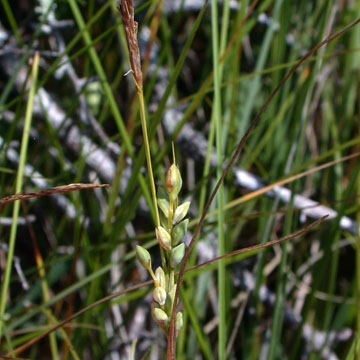

Carex tetanica - (image 1 of 3)
Taxonomy
Family: Cyperaceae
Section Paniceae
Habitat
Calcareous fens, swamps, meadows.
Associates
Distribution
MA to NJ and VA, west to MN, Alberta, and NE.
Morphology
Stems 20-60 cm, in small clumps on long, slender, deep, pale rhizomes, at least the fertile ones phyllopodic and often fibrillose at the base, the lower sheaths brownish or purple-tinged; leaves flat, 2-4.5 mm wide, surpassed by the culms; terminal spike staminate, on a rough peduncle, 7-40 mm long; bracts long-sheathing, the blade shorter than the stem; pistillate scale ovate, obtuse to acuminate or short-awned, brownish or purple tinged, with 3-nerved green center and hyaline margins; perigynia overlapping in mostly 3 rows, obovoid-fusiform, 2.5-3.5 mm, obscurely trigonous, with numerous fine nerves and 2 more prominent lateral ribs, broadest (1.5-2 mm) above the middle and evenly and broadly tapered or rounded to the beakless tip; achene broadly obovoid-trigonous, with concave sides, filling the perigynium.
Notes
Fruiting late May to July
Wetland indicator: FACW
Similar to C. meadii which is more wide-ranging and can occur in drier habitats as well as many of the same habitats as C. tetanica. In the Great Lakes region the two taxa seem to integrade and are difficult to separate. Carex meadii is typically more robust, with pistillate spikes 5-7 mm thick with about 6 rows of perigynia 2-2.5 mm wide.
Another similar species is C. woodii which occurs in rich woodlands and differs in being aphyllopodic with shallow, stout rhizomes and distinctive bladeless red basal leaf sheaths. It also has perigynia that are more 2-ranked, tapering above, and at least the lower ones not overlapping.
References
Ball, P.W. and A.A. Reznicek. 2002. Carex, In: Flora of North America Editorial Committee, Eds. Flora of North America North of Mexico. Volume 23. Oxford University Press, New York.
Gleason, Henry A. and A. Cronquist. 1991. Manual of Vascular Plants of
Northeastern United States and Adjacent Canada. Second Ed.
The New York Botanical Garden. Bronx, NY
|
© Michael Hough 2018 |